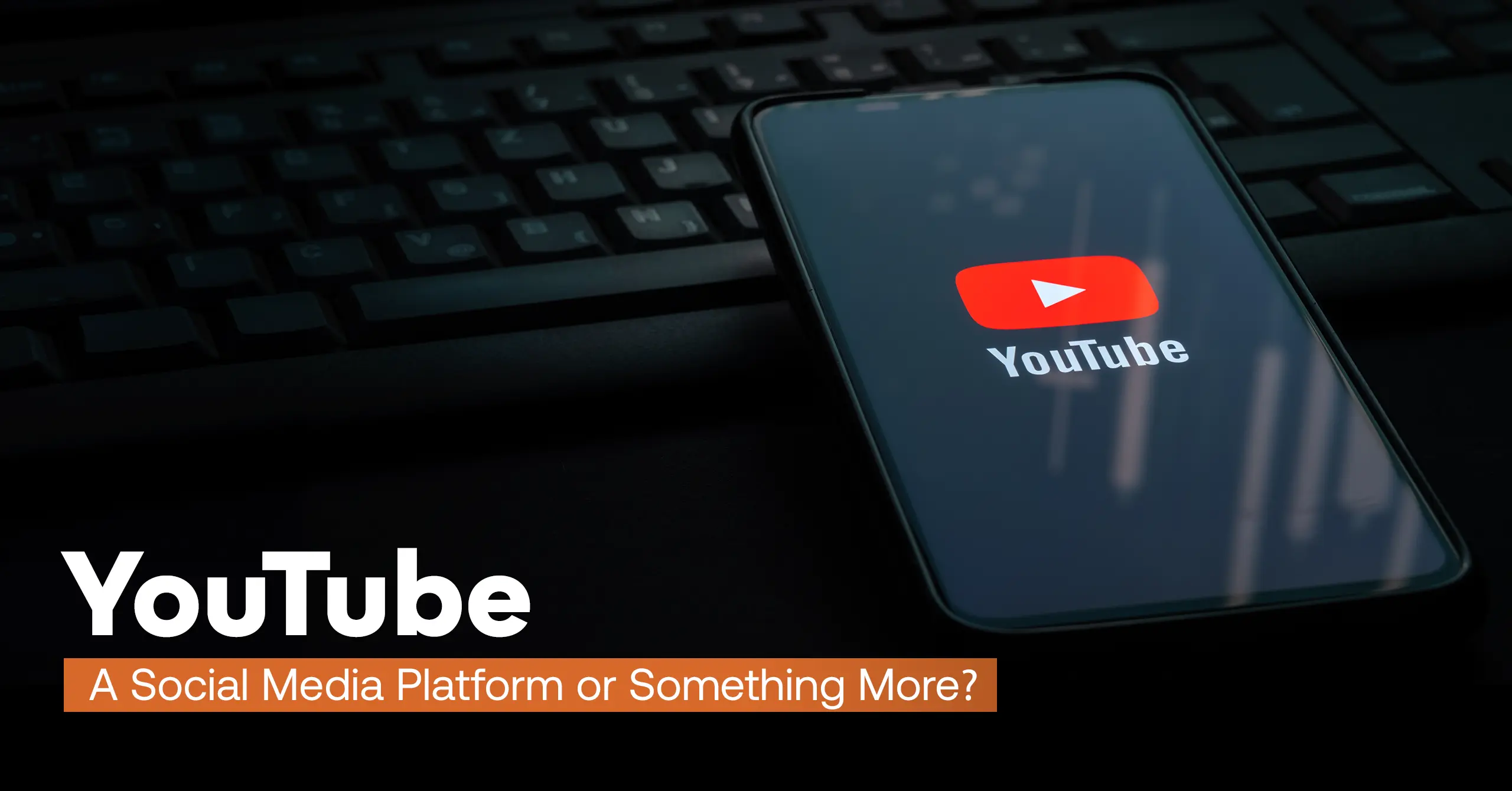YouTube: A Social Media Platform or Something More?

Every day, over 3.7 million videos hit YouTube. That’s 271,000+ hours of content daily—more than anyone could watch in a lifetime. But here’s the real tea: Is YouTube just another social platform, or is it the ultimate digital powerhouse?
Unlike Instagram and Facebook, YouTube isn’t about mindless scrolling—it’s a search engine, a content empire, and a career-launching powerhouse. It’s where trends are born, creators build empires, and entertainment meets education. So, does YouTube fit the social media mold, or is it too iconic to be labeled? Let’s get into it.
Is YouTube Considered a Social Media Platform? The Ongoing Debate
What Defines Social Media?
At its core, social media is about user interaction, content sharing, and community-building. Platforms like Facebook, Instagram, and Twitter thrive on likes, shares, and comments. YouTube? It has these features, but it’s different.
Instead of casual conversations or status updates, YouTube is content-driven. YouTube made $36.1 billion from advertising in 2024, a 14.6% increase from the previous year. It’s safe to say that YouTube is doing pretty well! People come for videos first, interaction second. Unlike TikTok, where content is fast and fleeting, YouTube thrives on long-form content that lasts years.
Google’s Perspective: How the Parent Company Classifies It
Google owns YouTube, and while it acknowledges the platform’s social elements, it mainly classifies it as a video-sharing service and search engine. In fact, YouTube is the second-largest search engine in the world after Google itself. That means users treat it more like a knowledge hub than a social space.
How Users Engage: Passive Watching vs. Active Participation
For many, watching YouTube videos has become part of their daily routine. 62% of internet users based in the United States report using YouTube every day. 92% access YouTube on a weekly basis, while 98% only use YouTube monthly. Think about it—when you open YouTube, do you immediately comment and engage, or do you just watch? Unlike Instagram, where interaction is instant, YouTube users primarily consume content.
Yes, there are comments, likes, and live chats, but most people watch videos in silence. It’s a passive experience rather than a real-time social engagement.
Also Read – Most Searched Topics on YouTube: Strategies for Content Creation
Does YouTube Fit the Social Media Mold, or Is It Something Else?
YouTube does have social features, but it operates on a different frequency. Unlike Facebook or Twitter, where interaction is the main goal, YouTube is content-first, social-second. That makes it part social media, part search engine, part streaming platform.
Traditional Social Media vs. Video-based Social Platforms
When you think of social media, platforms like Facebook, Instagram, TikTok, and Twitter likely come to mind. They thrive on real-time engagement, short-form content, and community-driven interactions. But where does YouTube fit in? While it has social features—such as likes, comments, and subscriptions—it functions quite differently. Its core focus is long-form content, searchability, and monetization, making it stand out from traditional social media networks.
To determine whether YouTube is truly a social media platform or an outlier, let’s compare it with some of the biggest names in the industry.
Facebook and Instagram: Social-first, Connection-driven
Facebook and Instagram were built around connecting people. Their primary function is social networking—friends, family, and influencers interact in real-time through posts, stories, direct messaging, and live streams. These platforms prioritize relationships, engagement, and trends.
Facebook is all about discussions, group interactions, and sharing personal updates. The algorithm favors content that sparks conversations, making it a social-first platform.
Instagram is highly visual, focusing on short-lived, aesthetically appealing content through posts, reels, and stories. It’s about instant engagement rather than deep, long-form content consumption.
Both platforms rely on social connections as their foundation. While YouTube allows for interaction, its engagement is not based on personal networks—it’s built around content discovery, making it fundamentally different.
TikTok: Short-form, Trend-based Video
TikTok has redefined video content with its rapid-fire, short-form approach. Unlike YouTube’s long-form, in-depth content, TikTok thrives on quick, entertaining clips that capture attention in seconds. Trends and challenges dominate the platform, encouraging mass participation.
TikTok’s algorithm aggressively pushes viral content, rewarding engagement within the first few hours of posting.
The content is fleeting—trending videos come and go, making longevity less important.
YouTube, on the other hand, prioritizes evergreen content—videos can gain views for years through search and recommendations. While both platforms revolve around video, their core strategies are vastly different.
Twitter: Real-time Discussions
Twitter is built for conversations, breaking news, and real-time interactions. Users post updates in short text-based messages, often responding to trends and live events.
It thrives on immediacy—tweets lose relevance quickly unless they go viral.
Engagement is driven by replies, retweets, and quick reactions rather than long-form content consumption.
YouTube doesn’t operate this way. While users can comment on videos, the interaction isn’t as instantaneous or discussion-driven as Twitter. Instead of quick conversations, YouTube fosters deeper content engagement.
YouTube: Evergreen Video Content, Search-driven, Long-form Engagement
Unlike these other platforms, YouTube isn’t just about social interaction—it’s about discovery, education, and entertainment.
- Searchability: YouTube is the second-largest search engine after Google. Users come looking for solutions, tutorials, and entertainment, not just to interact socially.
- Evergreen Content: Videos remain relevant for years, consistently attracting new viewers.
- Monetization Focus: While influencers on Instagram and TikTok earn through brand deals, YouTube offers a structured monetization system through ad revenue, memberships, and Super Chats.
YouTube as a Search Engine: The Second Largest in the World
Over 3 billion searches happen on YouTube every month. People go there to find answers, tutorials, and information. That makes it more like Google than Instagram.
Need to fix your car? Want to learn Photoshop? YouTube’s search function makes it an educational powerhouse.
Community and Engagement: The Role of Subscriptions, Comments, and Live Features
YouTube does foster community—subscriptions, memberships, Super Chats, and live streams all build creator-fan relationships. But unlike Facebook groups or Instagram stories, YouTube’s interactions feel more structured.
Users follow creators like mini TV channels, rather than casually scrolling through random updates.
A Hybrid Identity: How YouTube Blends Search, Social, and Streaming
YouTube isn’t just social media—it’s a mix of search engine, streaming service, and creator economy. It competes with Facebook for engagement, Netflix for content, and Google for information. That makes it a unique hybrid in the digital world.
Also Read – How to Reach Your First 5k Followers on YouTube: Essential Strategies
Does YouTube Count as Social Media, or Is It an Outlier?
Comparison with Other Platforms: Facebook, Instagram, TikTok, and Twitter
YouTube operates differently—it’s not about daily updates; it’s about content longevity and discovery.
Monetization and Content Longevity: A Platform for Creators or Social Users?
On Facebook and Instagram, posts disappear in hours. On YouTube? A well-optimized video can generate views and revenue for years.
Creators monetize through ads, sponsorships, and memberships, making YouTube more of a content business platform than a typical social network.
The Role of Algorithms: How YouTube Prioritizes Content vs. Social Engagement
Facebook and Instagram push recent and trending posts. YouTube? It prioritizes watch time, search relevance, and personalized recommendations.
That’s why you can still find a 10-year-old tutorial ranking on YouTube, but a 10-hour-old Facebook post is buried forever.
Audience Behavior: Learning, Watching, and Creating—Not Just Scrolling
People open Instagram to scroll mindlessly. On YouTube, users are looking for something specific—whether it’s entertainment, education, or product reviews.
That’s why YouTube content sticks, while Instagram content fades.
Why Some Say YouTube Is Not Social Media
Search Over Social: More Google Than Facebook?
YouTube functions more like Google than Facebook. People search for content instead of stumbling upon it through a feed.
Long-Form vs. Short-form Content: Why YouTube Prioritizes Depth Over Trends
Unlike TikTok’s 60-second bursts, YouTube videos can be hours long. Depth and storytelling matter more than fast trends.
Lack of Direct Messaging and Social Interactions
Most social platforms have direct messaging—YouTube doesn’t. Interaction happens in comments, but there’s no instant connection like Facebook or Twitter.
Monetization Focus: A Business Platform for Creators More Than a Social Hub
YouTube is built for creators. It’s less about chatting with friends and more about building a brand, monetizing content, and growing an audience.
YouTube: A Hybrid Platform That Defies Categories
Is YouTube a Social Media Platform, a Search Engine, or a Streaming Service?
It’s all three. YouTube is a blend of search, social, and entertainment, making it a digital giant unlike anything else.
How Brands and Marketers Use YouTube Differently From Other Social Networks
While brands use Facebook for community engagement, they use YouTube for brand awareness, education, and lead generation.
Why YouTube’s Hybrid Identity Gives It an Edge in 2025 and Beyond
With its searchability, evergreen content, and creator-focused model, YouTube isn’t going anywhere. In fact, its unique position makes it stronger than traditional social media.
Social Media and Beyond—YouTube’s Expanding Digital Ecosystem
So, is YouTube social media? Yes, but it’s also much more. It’s a search engine, a business platform, and a streaming powerhouse.
In 2025 and beyond, YouTube’s ability to blend education, entertainment, and monetization gives it an unmatched advantage. Whether you’re watching, learning, or building a brand, YouTube isn’t just social media—it’s the future of digital content.


